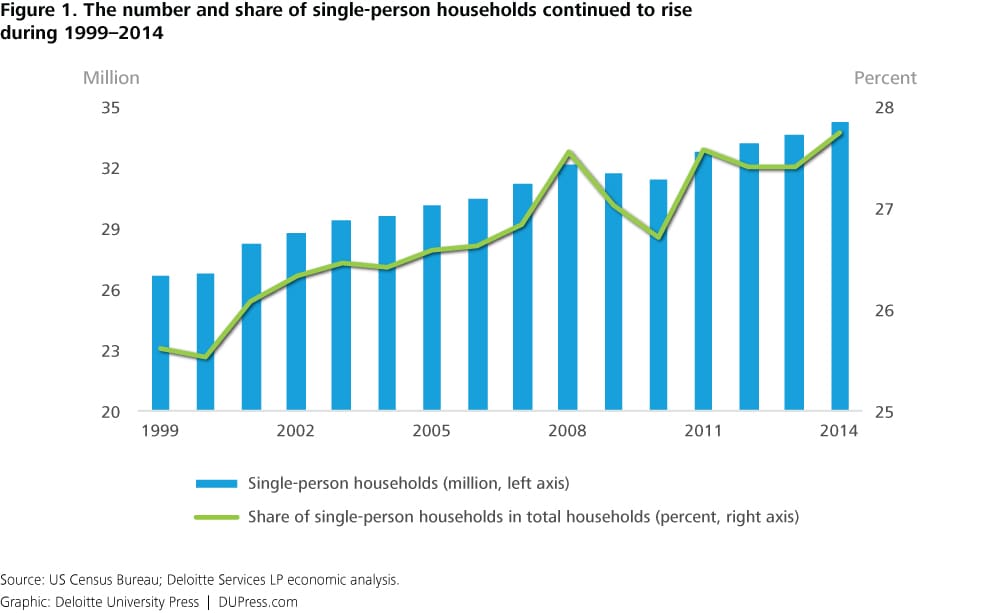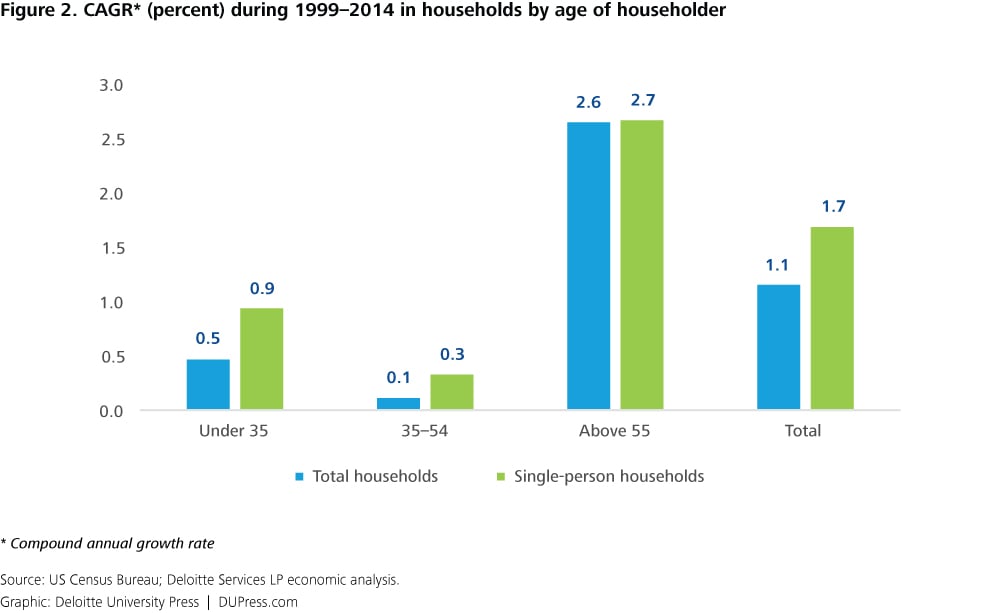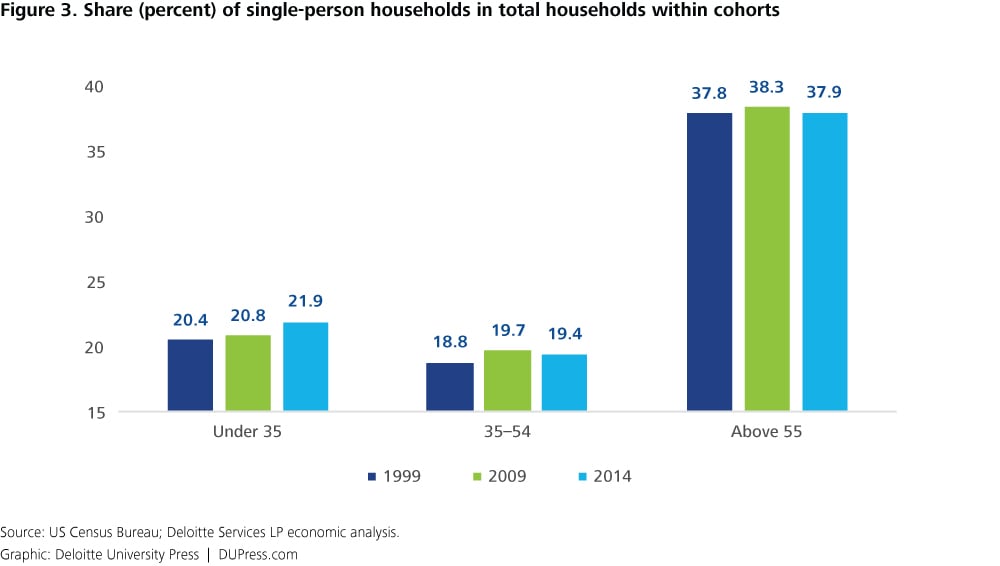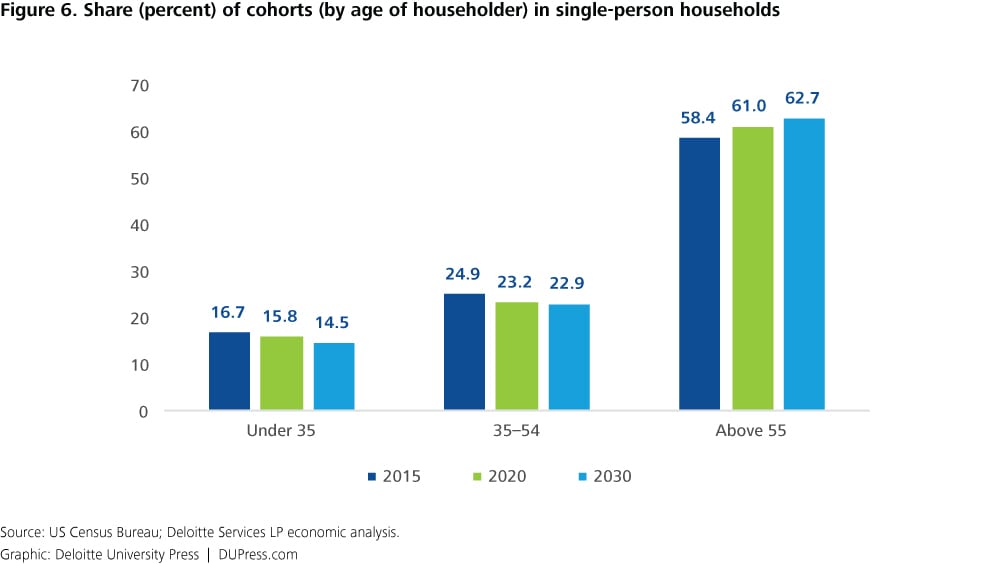Single-person households: Another look at the changing American family has been saved

Single-person households: Another look at the changing American family Behind the Numbers, November 2015
13 November 2015
Single-person households in the United States are set to grow steadily over the next 15 years, which could have implications for several industries, ranging from housing to health care.
Explore
View the Behind the Numbers collection, a monthly series from Deloitte’s economists.
The American household is very different from the idealized image of the nuclear family. Not only are children less likely to live with two opposite-sex parents, but many households are organized in non-traditional ways. One of the key changes is the increase in single-person households: adults living alone. At one time, this was considered very unusual. But it is becoming more normal, and may have profound implications for many businesses. To better understand this phenomenon, we have developed a simple forecast of the number and share of single-person households in the United States.
Single-person households have been rising steadily
Changing lifestyle trends and attitudes to marriage have impacted not only the size of households, but the nature of households as well. For example, between 1960 and 2014, the median age of first marriage rose to 29.3 years for men and 27.0 years for women from 22.8 years and 20.3 years, respectively.1 During this time, the share of single-person households in total households more than doubled to 27.7 percent and the average number of people per household fell to 2.54 from 3.33.2
While the sharpest rise in single-person households took place between 1960 and 1980, it’s worth taking a deeper look at the trends over the last 15 years in light of Millennials’ entry into the labor force and the continued impact of the Great Recession.
The trends in single-person households over 1999–2014
Between 1999 and 2014, the number of single-person households went up to about 34.2 million from 26.6 million, an average annual rise of 1.7 percent.3 Growth in total households during the same period was lower (1.1 percent), leading to a more than 2 percentage point rise in the share of single-person households in total households (figure 1).
Given the delay in the median marriage age, it is not surprising that households headed by those under 35 years of age and by 35–54-year-olds have witnessed faster growth in single-person households than total households for their respective cohorts (figure 2). As a result, for both cohorts, the shares of single-person households in total households within their cohorts went up (figure 3). Interestingly, the above-55 cohort outpaced the other two, both in formation of total households and single-person households. Consequently, the cohort’s share in overall single-person households in the country went up between 1999 and 2014 (figure 4).
How will the numbers look like in the next 15 years?
The US Census Bureau provides projections for population, but not households. We made some simple assumptions to develop a projection of the number of households and single-person households in the future.
- Step 1. Projecting data for all households From historical data, we first calculate the share of the population in a particular cohort (under 35, 35–54, and above 55) who are heads of households. Then, assuming that the future share for a cohort stays the same as the latest available year (in this case, 2015), we multiply these shares with the population projections to arrive at a projection of the total number of households for each cohort. The assumption of static shares is a baseline assessment and is in line with trends for the last decade. Even for the under-35 cohort, the share of the population who are heads of households did not fall sharply after the Great Recession and has been slowly edging up since then.
- Step 2. Projecting data for single-person households Next, we calculate the share of single-person households in total households within the three cohorts for the most recent available year (in this case, 2014). Then, assuming that the future share for a cohort does not change, we multiply these shares with the household projections (from step 1) to obtain a projection of the number of single-person households for each cohort. As figure 3 shows, the assumption that the share of single-person households within cohorts is fixed reflects historical experience (except possibly for the youngest cohort).
The projections show that single-person households are set to reach about 41.4 million by 2030, an average annual rise of 1.1 percent over 2015–2030. The projections also show that the numbers will somewhat stabilize for the under-35 cohort, rise steadily for the above-55 cohort, and pick up sharply after 2020 for the 35–54 cohort (figure 5).
The downward movement in shares of single-person households of the under-35 and 35–54 cohorts is expected to continue during 2015–30 as in the previous 15-year period. The above-55 cohort is expected to make up 62.7 percent of all single-person households in the country by 2030 (figure 6).
What are the implications of rising single-person households?
Rising numbers of single-person households may have numerous implications for the economy.
Single-person households tend to spend more on housing than other cohorts.4 These households may prefer to rent rather than buy houses. And even if they do buy a house, the preference is for multifamily homes rather than single-family ones. This may influence the structure of the housing market, which is still recovering from the impact of the Great Recession and recent changes in housing finance.5
A rise in single-person households may aid labor market mobility. With fewer attachments to property and free of marital burdens, these individuals may be more open to shifting cities for jobs. This could make the labor market more mobile than it is today.
However, single-person households will have to cope with lower availability of informal personal care from partners. Such nonmarket production (as economists would define it) may need to be replaced by purchased personal care services, especially health and nursing care, which could significantly impact the health care industry.
© 2021. See Terms of Use for more information.










